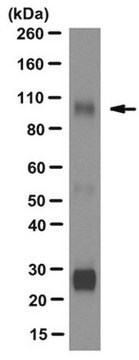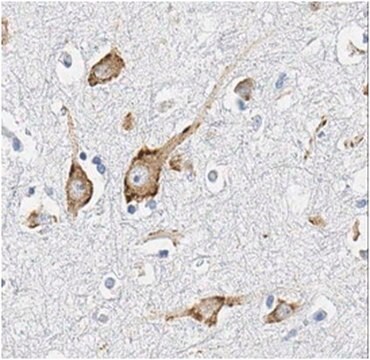ABE69
Anti-PTIP Antibody
from chicken, purified by affinity chromatography
Sinonimo/i:
PAX interacting (with transcription-activation domain) protein 1, PAX transactivation activation domain-interacting protein, protein encoded by CAG trinucleotide repeats, PAX transcription activation domain interacting protein 1 like
About This Item
Prodotti consigliati
Origine biologica
chicken
Livello qualitativo
Forma dell’anticorpo
affinity isolated antibody
Tipo di anticorpo
primary antibodies
Clone
polyclonal
Purificato mediante
affinity chromatography
Reattività contro le specie
rat, mouse, human
tecniche
immunofluorescence: suitable
immunohistochemistry: suitable
western blot: suitable
N° accesso NCBI
N° accesso UniProt
Condizioni di spedizione
wet ice
modifica post-traduzionali bersaglio
unmodified
Informazioni sul gene
human ... PAXIP1(22976)
Descrizione generale
Immunogeno
Applicazioni
Immunofluorescence Analysis: A represenative lot was used by an independent laboratory in IF (Lechner, M., et al. (2000).
Epigenetics & Nuclear Function
Chromatin Biology
Qualità
Western Blot Analysis: A 1:1,000 dilution of this antibody detected PTIP in 10 µg of A431 cell lysate.
Descrizione del bersaglio
Other isoforms may be observed in some lysates.
Stato fisico
Stoccaggio e stabilità
Risultati analitici
A431 cell lysate
Esclusione di responsabilità
Non trovi il prodotto giusto?
Prova il nostro Motore di ricerca dei prodotti.
Codice della classe di stoccaggio
12 - Non Combustible Liquids
Classe di pericolosità dell'acqua (WGK)
WGK 1
Punto d’infiammabilità (°F)
Not applicable
Punto d’infiammabilità (°C)
Not applicable
Certificati d'analisi (COA)
Cerca il Certificati d'analisi (COA) digitando il numero di lotto/batch corrispondente. I numeri di lotto o di batch sono stampati sull'etichetta dei prodotti dopo la parola ‘Lotto’ o ‘Batch’.
Possiedi già questo prodotto?
I documenti relativi ai prodotti acquistati recentemente sono disponibili nell’Archivio dei documenti.
Il team dei nostri ricercatori vanta grande esperienza in tutte le aree della ricerca quali Life Science, scienza dei materiali, sintesi chimica, cromatografia, discipline analitiche, ecc..
Contatta l'Assistenza Tecnica.








